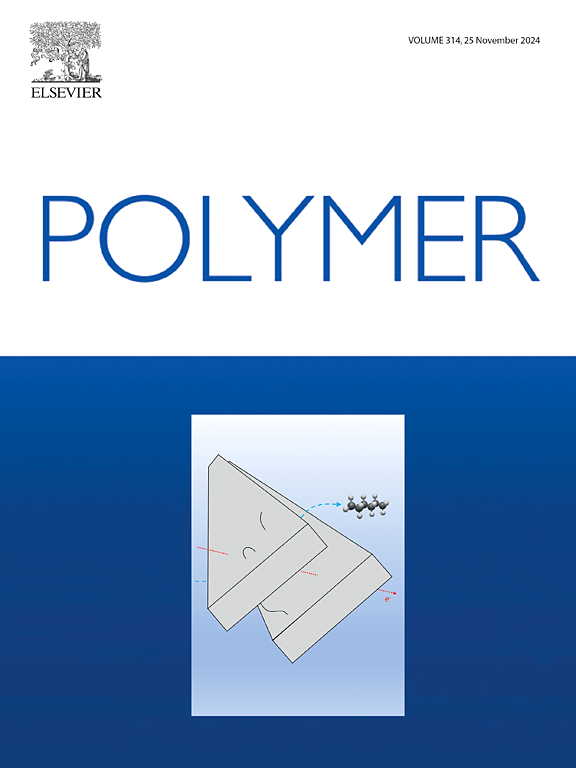Synthesis, characteristics and thermally induced self-assembly of silicon-based thermo/photo-responsive block copolymers prepared from monomer bearing paired side-chain azo mesogens using RAFT process
IF 4.1
2区 化学
Q2 POLYMER SCIENCE
引用次数: 0
Abstract
Novel silicon-based liquid crystalline (LC) monomer (CASPA) and corresponding Poly(MMA)-b-Poly(CASPA) diblock copolymers (DBCs) containing symmetric azobenzene mesogens in the side chain were successfully synthesized by coupling reaction and reversible addition-fragmentation chain transfer (RAFT) polymerization, respectively. Block copolymerization by RAFT proceeded with well-controlled manner in anisole solution involving new CASPA monomer, Poly(MMA)-RAFT macroinitiator and AIBN initiator, yielding Poly(MMA)-b-Poly(CASPA) DBCs with excellent control over molecular weights (Mw/Mn ≤ 1.39) and compositions. Chemical structures and properties of CASPA and Poly(MMA)-b-Poly(CASPA) were extensively studied using 1H NMR, FTIR, GPC, DSC, POM, AFM and GISAXS. The CASPA exhibited enantiotropic liquid crystallinity with nematic four-brush schlieren texture, while DBCs showed monotropic liquid crystallinity with batonnet textures of smectic A phase. All DBC films exhibited photochemical trans-cis isomerization and photoinduced phase transition from mesophase to isotropic phase under UV irradiation. Morphologies of DBC thin films under thermal annealing depended on volume ratio of building LC block relative to Poly(MMA) segment, DBC-2 containing approximately equal block volume fractions self-assembled into lamellar nanostructure with domain-spacing of 34 nm, whereas DBC-3 and DBC-4 possessing higher LC contents (65 wt% and 72 wt%) formed highly ordered hexagonal cylindrical nanostructures with domain-spacing ranging from 37 to 39 nm as evidence by AFM and GI-SAXS, conforming with the self-consistent field theory.


利用 RAFT 工艺制备硅基热/光响应嵌段共聚物(由含有成对侧链偶氮中间体的单体制备)的合成、特性和热诱导自组装
通过偶联反应和可逆加成-断裂链转移(RAFT)聚合反应,分别成功合成了新型硅基液晶(LC)单体(CASPA)和相应的侧链中含有对称偶氮苯中间体的聚(MMA)-b-聚(CASPA)二嵌段共聚物(DBCs)。新型 CASPA 单体、聚(MMA)-RAFT 大引发剂和 AIBN 引发剂在苯甲醚溶液中以良好的控制方式进行了 RAFT 嵌段聚合,得到了分子量(Mw/Mn ≤ 1.39)和组成控制极佳的聚(MMA)-b-聚(CASPA)DBC。使用 1H NMR、FTIR、GPC、DSC、POM、AFM 和 GISAXS 对 CASPA 和 Poly(MMA)-b-Poly(CASPA) 的化学结构和性质进行了广泛研究。CASPA 显示出具有向列四刷分裂纹理的各向异性液晶,而 DBC 则显示出具有纺锤形 A 相纹理的单向性液晶。在紫外线照射下,所有 DBC 薄膜都表现出光化学反式-顺式异构化和从介相到各向同性相的光诱导相变。热退火条件下 DBC 薄膜的形态取决于构建 LC 嵌段相对于 Poly(MMA) 嵌段的体积比,嵌段体积分数大致相等的 DBC-2 可自组装成域间距为 34 nm 的片状纳米结构,而 LC 含量较高的 DBC-3 和 DBC-4 (分别为 65 wt% 和 72 wt%)可形成高度有序的六边形圆柱纳米结构,经原子力显微镜和 GI-SAXS 验证,其域间距为 37 至 39 nm,符合自洽场理论。
本文章由计算机程序翻译,如有差异,请以英文原文为准。
求助全文
约1分钟内获得全文
求助全文
来源期刊

Polymer
化学-高分子科学
CiteScore
7.90
自引率
8.70%
发文量
959
审稿时长
32 days
期刊介绍:
Polymer is an interdisciplinary journal dedicated to publishing innovative and significant advances in Polymer Physics, Chemistry and Technology. We welcome submissions on polymer hybrids, nanocomposites, characterisation and self-assembly. Polymer also publishes work on the technological application of polymers in energy and optoelectronics.
The main scope is covered but not limited to the following core areas:
Polymer Materials
Nanocomposites and hybrid nanomaterials
Polymer blends, films, fibres, networks and porous materials
Physical Characterization
Characterisation, modelling and simulation* of molecular and materials properties in bulk, solution, and thin films
Polymer Engineering
Advanced multiscale processing methods
Polymer Synthesis, Modification and Self-assembly
Including designer polymer architectures, mechanisms and kinetics, and supramolecular polymerization
Technological Applications
Polymers for energy generation and storage
Polymer membranes for separation technology
Polymers for opto- and microelectronics.
 求助内容:
求助内容: 应助结果提醒方式:
应助结果提醒方式:


